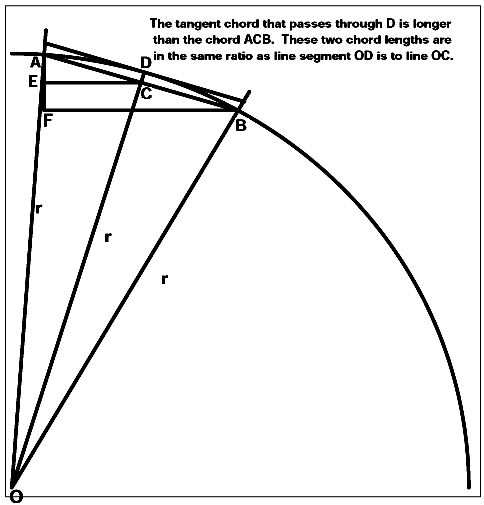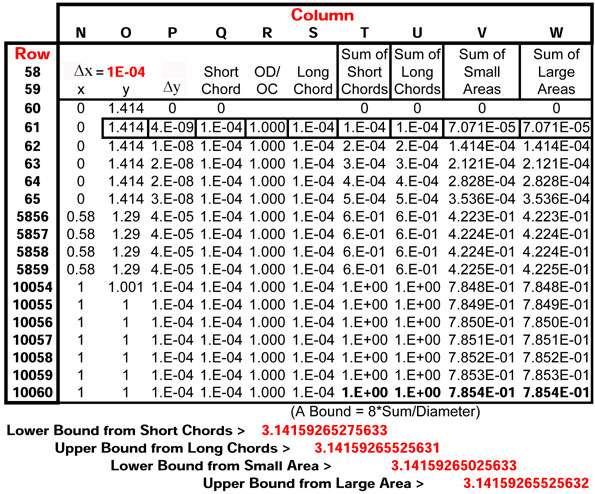Such bounds will enable estimation of
the error that may exist when determining either circumference from a given diameter
or area from a given radius. To determine these bounds, consider the 90
o circle
segment shown next.

To proceed, underestimate the circumference by summing the short chords as seen on the
circle segment and then overestimate the circumference by summing the longer tangent chords.
If a very small step
size is chosen for the calculations these two bounds should lie very close together.
Note that the ratio of the length of the longer tangent chord to the length of the
short chord is the same as the ratio of the length OD to the length OC.
The length of line OD is the radius r as are the lengths OA and OB, where r = √2.
Let the
length of FB be ∆x and the length of AF be ∆y. Let the coordinates of point A be (x,y). Then the coordinates of point C are: ( (x+∆x)/2, (y- ∆y)/2).
AB is the hypotenuse of the rt triangle AOB. The length of the short chord,
AB, is:
From the coordinates of C find the length OC as:
|
OC = √
|
(x+∆x/2)2 + (y
- ∆y/2)2
|
For our circle with radius √2 the ratio OD/OC is just √2 /OC. This is
the ratio of the length of the tangent chord to the length of the short chord.
Moving to the
ratio of a circle's area to the square of its radius,
a lower bound on this ratio will be found by summing the areas of the inner isosceles triangles AOB, and an upper bound will be found by summing the areas of
the outer isosceles triangles that are based on the, long, tangent chord. (
For
an isosceles triangle, its area is given by multiplying its height by half the
length of its base.)
To assure close bounds, 10,000 steps in x, 0 <= x <= 1, were employed in the top 45
o
segment of the circle for
the calculations. See sample cells of the spread sheet, shown using scientific notation, in the table following:

The expressions in row 61 can be viewed by clicking the
(column, row) addresses that follow.
|
N61 |
O61 |
P61 |
Q61 |
R61 |
S61 |
T61 |
U61 |
V61 |
W61 |
The upper and lower bounds provided by the chords are closer together than those
for the areas. The sought ratio lies between 3.14159265
275...
and 3.14159265
525.... The exact value is known as Pi with the
symbol
π.
Pi is, as are most numbers, a transcendental number. See
Wikipedia for more information on transcendentals.
Pi requires an indefinitely
large number of numeric digits for precise representation. Its calculation
has been a challenge to many and more than 1012
of its most significant digits have now been found.
A published approximation
is: π =3.141592653589793 which is seen to lie nicely within
our calculated bounds. Using such a value for the ratios, the errors in calculating a circle's:
circumference = π * d,
and area = π * r2,
given a circle's
diameter or radius,
will be quite small.
The circumference C of a circle is equivalently represented as:
C = 2 * π * r and
for the
unit circle, C = 2 * π.
For this and other reasons, angle is often expressed
in units of the path length around the unit circle. Such angles
are termed
radians with 2π radians
equivalent to 360o.
Neatly, the internal angles of a plane triangle sum to π radians.
As an exercise, the reader should consider how to
calculate a table of sines or cosines, in small equal steps of angle, and
construct it using a spreadsheet.
Next
Numerical Optimization is introduced in conjunction with a design problem.